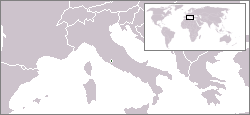Rome/Vatican
The Vatican City (Italian: Città del Vaticano; Latin: Civitas Vaticana) is the world's smallest country both by area and by population, and is the center of Catholicism. As a district of Rome, it encompasses the Vatican City State (Italian: Stato della Città del Vaticano; Latin: Status Civitatis Vaticanae), as well as the surrounding Roman neighborhoods of Borgo and Prati. St. Peter's Basilica, the Vatican Museums and the Sistine Chapel are all in Vatican City. This tiny country completely within Rome is packed with more history and artwork than most cities in the world, and indeed many countries.
Understand
The Vatican City is the temporal seat of the Pope, head of the worldwide Catholic Church. Situated within the city of Rome, the Vatican is the world's smallest sovereign state. You may also hear the term Holy See (Italian: Santa Sede; Latin: Sancta Sedes), which is used to refer to the Diocese of Rome—that is, the ecclesiastical and administrative authority of the Pope, rather than the sovereign governmental entity that is the Vatican City State.
History
Vatican City is all that remains of the Papal States, the former temporal land holdings of the Pope. Over the years, this territory varied considerably in extent, and may be traced back to AD 756 with the "Donation of Pepin". However, the popes had been the de facto rulers of Rome and the surrounding province since the fall of the Roman Empire and the retreat of Byzantine power in Italy. Popes in their secular role ruled portions of the Italian peninsula for more than a thousand years until the mid 19th century, when many of the Papal States were seized by the newly united Kingdom of Italy. In 1870, the pope's holdings were further circumscribed when Rome was annexed.
Disputes between a series of "prisoner" popes and Italy were resolved in 1929 by three Lateran Treaties, which established the independent state of Vatican City, granted Roman Catholicism special status in Italy, recognized the full sovereignty of the Vatican and established its territorial extent. In 1984, the agreement was revised to eliminate Catholicism's position as the only state religion of Italy, but the essential features of the agreement remain in force today.
Diplomacy
The Holy See — the headquarters of the Roman Catholic Church which is housed in Vatican City — has diplomatic recognition from the overwhelming majority of countries in the world and has permanent observer status in numerous international organizations, including the United Nations General Assembly.
Although there are Papal nuncios (equivalent to ambassadors) in many foreign capitals, due to its limited size the Vatican does not house any diplomatic missions; instead, foreign embassies to the Holy See are based in other parts of Rome. This means that Italy hosts its own Embassy of Italy to the Holy See.
According to an agreement between the Holy See and Italy, foreign missions to Italy are not allowed to double as missions to the Holy See. Therefore, many countries have two embassies in Rome: one to Italy and another to the Holy See. Other countries that maintain diplomatic relations with the Holy See but don't have a second embassy in Rome have their missions in another country (usually in Bern, Switzerland) double as representatives to the Holy See.
Terrain
The Vatican is between 19 m (62 ft) and 75 m (246 ft) above sea level. With a perimeter of only 3.2 km (2 mi), the Vatican City is not just the smallest country in the world, it's smaller than some shopping malls! Most of the area consists of the Vatican Gardens.
Population
Although 1,000 people live within Vatican City, many dignitaries, priests, nuns, guards, and 3,000 lay workers live outside the Vatican. It has about 800 citizens, making it the smallest nation by population on the globe. The Vatican fields a soccer team composed of the Swiss Guard, who holds dual citizenship.
Read
- Inside the Vatican by Bart McDowell. A light run-through of the history of the Vatican, with a particular focus on some of the recent Popes. It is illustrated with extensive photographs of the going-ons in this tiny country.
Get in
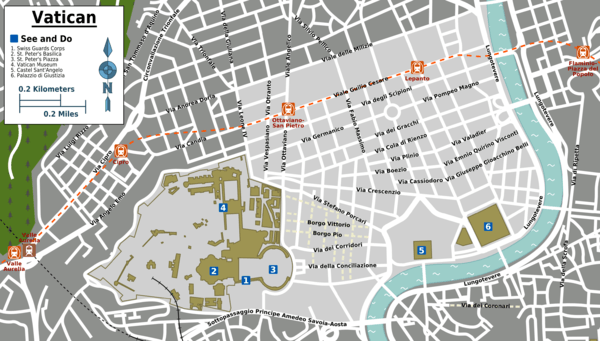
Although Vatican City is not a signatory to the Schengen agreement, there are no immigration formalities involved in crossing the border from Italy to Vatican City and vice versa, making it a de facto part of the Schengen area. Entry to the Vatican is as simple as traveling to any other part of Rome, though you do have to go through a metal detector when entering the Vatican Museums or St. Peter's Square.
By taxi or foot
It's easy to get to the Vatican by taxi or foot from Rome. There are 3 road entrances to Vatican City: from Via della Stazione Vaticana, Via Paolo VI and Borgo Pio. The entrance from Borgo Pio leads to the Vatican Museum, and the other two leads to St. Peter's Basilica.
By bus
There are several bus stations beside Vatican City. For the St. Peter's Basilica and Square, the #64 bus goes from central Rome right to the southern end of the Vatican, but it is filled with pickpockets so guard your valuables! From western Rome, the #46 bus also goes to St. Peter's Basilica and Square.
For the Vatican Museums, the #49 bus goes from western Rome to the northern end of Vatican City. The gate to the Vatican Museums is carved on the wall right beside the bus station.
By metro
Take the metro 🌍 Cipro A for the Museums, and 🌍 Ottaviano A for St. Peter's. To go from Cipro to the Museums, go east through Via Candia and then turn right at Via Santamaura. To go from Ottaviano to St. Peter's, go south through Via Ottaviano. A fun trip is to take the tram to Piazza del Risorgimento.
By train
It's a little-known fact that the Vatican has its own train station. Historically, it has been used by the Pope for special travel on Italian rail or to send off papal remains.
Since 2014, there has been a tour package each Saturday departing from the Vatican City railway station, spending the day at the Vatican Museums, Sistine Chapel, Vatican Gardens and the Pontifical Villas of Castel Gandolfo, then returning to the Roma San Pietro station. In 2019, a full ticket of the tour cost €42.
By plane
Vatican City does not have an airport, but there is a heliport that is only used by the Pope. The closest airport is the Leonardo da Vinci–Fiumicino Airport in Rome.
Get around
With 109 acres (44 hectares) within its walls, the Vatican is easily traveled by foot; however, most of this area is inaccessible to most tourists. The most popular areas open to tourists are the St. Peter's Basilica and Square and the Vatican Museums.
Talk
- See also: Italian phrasebook
Latin enthusiasts rejoice! There is one country in the world that holds Latin (in addition to Italian) as its official language, and the able traveler is invited to check out the urban legend that you can indeed get by within the city-state only using the "dead" language. Italian, however, remains the more useful of the two. English is widely spoken here, as are most major languages of the world.
See
There is a lot of artwork to see in Vatican City.
St. Peter's Basilica
The center of the Catholic world, this magnificent basilica with its Michelangelo-designed dome has an awe-inspiring interior. This place is huge, but everything is in such proportion that the scale escapes you. Construction of the basilica began in 1506 and it was not completed until the end of 1626. Thus it spans two architectural periods. The overall design by Bramante and Michelangelo is Late Renaissance but the façade designed by Maderno and the interior, which owes much to Bernini, are both Baroque in style. The interior is lavishly decorated and contains a large number of tombs of popes and others. There are also several sculptures in side chapels, including Michelangelo's Pietà.
To get in, you will first go through a metal detector (after all, this is an important building). Don't be put off if there is a long line in front of the detectors; the whole thing moves quickly. The line is usually shorter in the morning and during mid-week. A strict dress code is enforced, so have shoulders covered, wear trousers or a not-too-short dress, and take your hats off. Women must wear scarves or something to cover their heads. You might be required to check your bags at the entrance. Photos are allowed to be taken inside, but not with a flash. Visits to the basilica are still possible while Mass is in progress.
Free admission.- The dome, which dominates Vatican City, has a total height of 136.57 meters (448 ft) from the floor of the basilica to the top of the external cross. It is the tallest dome in the world. Its internal diameter is 41.47 meters (136 ft), slightly smaller than the Pantheon and the cathedral at Florence. Most of the final design was by Michelangelo, building on earlier designs by Bramante and Sangallo and taking much of his inspiration from the cathedral of Florence. After Michelangelo's death in 1564, the work was completed by Giacomo della Porta. You can take an elevator up to the roof and then make a long climb up 323 steps to the top of the dome for a spectacular view. Taking the elevator costs €8 (€6 to climb the stairs) and you should allow an hour to go up and down. During the climb and before reaching the very top, you will find yourself standing on the inside of the dome, looking down into the basilica itself. Be warned that there are a lot of stairs so it is not for the faint at heart (literally or figuratively) nor those suffering from claustrophobia as the very last section of the ascent is through little more than a shoulder-width spiral staircase. The dome opens one hour after the basilica and closes one hour before the basilica.
- In the first chapel on the right as one enters the basilica is a Pietà, the first of four works on the same theme by Michelangelo depicting the body of Jesus on the lap of his mother Mary after the Crucifixion. The sculpture, in Carrara marble, was made for the funeral monument of the French Cardinal Jean de Billheres and was moved to its current location in the eighteenth century. It is the only piece Michelangelo ever signed. In 1972 the Pietà was attacked by a mentally disturbed person using a geologist's hammer, which is why it now appears behind a bullet-proof glass wall. Reconstruction was not helped by the fact that some onlookers helped themselves to fragments after the attack.
- Underneath the altar in the second chapel on the right are the remains of Pope John Paul II.
- The first chapel in the south aisle, on the left as you enter, is the baptistry. The font is a fourth-century sarcophagus but its lid comes from another sarcophagus, which held the remains of Emperor Hadrian. This lid was dropped by workmen, broke into ten pieces, and was subject to expert restoration, with the gilt-bronze figure of the "Lamb of God" being added at that time. The tomb of Pope Alexander VII, towards the end of the aisle, is by Bernini and is considered a masterpiece of Baroque art. The tomb is supported by four female figures. The two at the front represent Charity and Truth. The foot of Truth rests upon a globe of the world, her toe being pierced by the thorn of Protestant England. The Baroque period coincided with the Reformation and St. Peter's was seen as an affirmation of Catholicism.
- The central internal feature is the Bernini-designed baldachin, or canopy, built over the Papal Altar underneath the dome. The baldachin had to be enormous to avoid being overwhelmed by the size of the basilica. To obtain the quantity of bronze required, Bernini was given permission by Pope Urban VIII to strip it from the portico of the Pantheon. It is considered to be one of the great works of the Baroque period and remains the largest bronze sculpture in the world.
- Against the northeast wall of the dome is a statue of St. Peter. One foot of the statue has been largely worn away by pilgrims kissing it over the centuries. Set in niches under the dome are four statues associated with holy relics held in the basilica including one of St. Longinus holding the spear that pierced the side of Jesus, by Bernini.
- In the apse, at the far end of the basilica, is a large bronze throne, also by Bernini. Known as the "Cathedra Petri" or throne of St. Peter the throne houses a chair which was claimed to have been used by Saint Peter, but is more likely to date from the twelfth century.
Free 90-minute tours leave daily from the Tourist Information Center at 14:15, many days also at 15:00. Telephone: 06-6988-1662. €5 audio-guides can be rented from the checkroom.
The Pope
If you want to see the pope, you can either see a usual blessing from his apartment at the Apostolic Palace on noons on Sundays, just show up (but in the summer he gives it from his summer residence at Castel Gandolfo, 25 km from Rome) or you can go to the more formal Wednesday appearance. The pope arrives in the popemobile at 10:30 to bless crowds from a balcony or platform, except in winter, when he speaks in the Aula Paolo VI Auditorium next to the square. You can easily watch from a distance, or get a free ticket, which you must get on the Tuesday before. There are a number of ways:
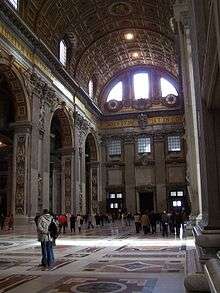
- Your hotelier may be able to book one for you
- You could wait in a long line at St. Peter's on Tuesday where the Swiss Guards hand out tickets at their post to the right of the basilica, after 12:00 on Tuesday
- You could contact the Santa Susanna Church to get you a ticket (online or call 06-4201-4554), which you pick up there on Tuesday between 17:00 & 18:45, on Via XX Settembre, Metro stop: Repubblica.
- Finally, to book a free spot in the square or auditorium, call 06-6988-4631
The pope also gives masses during Christmas and Easter. He may occasionally be away on a state visit, however.
St. Peter's Square
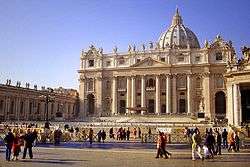
Most of the Piazza di San Pietro is actually an oval. There is a small, almost rectangular section immediately in front of the St Peter's and an opening to the Via della Conciliazione opposite the basilica. There are two stones (one on each side of the square) between the obelisk and the fountains. If you stand by either of these stones, the four columns on the colonnades merge into one. In total there are 284 columns. When Bernini came to design the piazza he had to incorporate the obelisk and a fountain designed by Maderno, both of which were already there. The symmetry of the square was enhanced by the addition of another fountain, designed by Bernini.
The obelisk in the middle of the square was transported from Egypt to Rome in 37 AD by Emperor Gaius Caligula to mark the spine of a circus eventually completed by Emperor Nero. The so-called Circus of Nero was parallel to and to the south of the east-west axis of the current Basilica. It was here that Saint Peter was killed in the first official persecutions of Christians undertaken by Nero beginning in 64 AD, and continuing until his death in 67 AD. The original location of the obelisk is marked with a plaque located near the sacristy on the south side of the basilica, where it remained until it was moved in 1586 AD by Pope Sixtus V to its present location.
During the Middle Ages, the bronze ball on top of the obelisk was believed to contain the ashes of Julius Caesar. When it was relocated it was opened and found to be empty. The present reliquary, the Chigi Star in honor of Pope Alexander VII, was added containing pieces of the "True Cross". This is the only Egyptian obelisk in Rome that has never toppled since being erected in Ancient Rome and is the second largest Egyptian obelisk after the Lateran obelisk. The obelisk nearly shattered while it was being moved. Upon orders of the pope, no one was to speak a word while it was being moved otherwise they would be excommunicated. However, a sailor shouted to water the ropes to prevent them from burning. He was forgiven and in gratitude for saving the day, the palms for Palm Sunday still come from the sailor's home town of Bordighera in Portugal. The moving of this obelisk was celebrated in engravings during its time to commemorate the Renaissance's recovery and mastery of ancient knowledge.
Until the Fascist era visitors approached St. Peter's Square from the Tiber River by two narrow parallel streets that did not provide the same views as seen today. Mussolini dictated that a warren of poor houses be knocked down to make way for the Via della Conciliazione and the new buildings alongside it. The name of the street commemorates the Lateran Treaty of 1929, under which the Vatican was recognized as an independent state by the Italian government.
The square is generally very crowded, even on weekdays, even during rain. Many times during the year, it will be full of barricades, tents or other objects. Do not have high hopes of getting a good picture of yourself in the St. Peters square without the crowd or other obstructions.
Free admission.The Vatican Museum
One of the greatest art galleries in the world, the museum is most famous for its spiral staircase, the Raphael Rooms and the exquisitely decorated Sistine Chapel famous for Michelangelo's frescoes. Much of the museum is organized so you follow a one-way route leading to Raphael's rooms and the Sistine Chapel but there is much more to see as well. If you are very short of time, it will take at least an hour to visit the Sistine Chapel.
The Museum is usually crowded on Saturdays, Mondays, the last Sunday of the month, rainy days, and days before or after a holiday but, basically, it is crowded every day and if you want to see the gems that it contains you will have to tolerate the crowds or sign up to very expensive private tours after the museum is closed to everyone else. Dress code: no short shorts or bare shoulders. There are often lengthy queues from the entrance that stretch around the block in the early morning. Non-guided visitors should join the queue that is to the left as you are facing the entrance; the queue on the right is intended for guided group visitors. You can book online in advance and with a booking, you can skip the queue. Audio-guides are available from the top of the escalator/ramp for €7. Two people can share a single unit plugging in a standard set of earphones.
€16 adults, €8 concessions. Additional €4 booking fee per ticket if booked online in advance.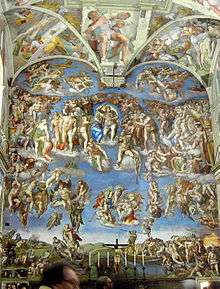
- The Sistine Chapel is a rectangular brick building with no exterior decoration. There is no exterior entrance, it being approached from within the Vatican buildings. Inside, the walls are divided into three levels. The lower is decorated with frescoed wall hangings. The middle of the walls has two cycles of paintings, "The Life of Moses" and "The Life of Christ", painted by Ghirlandaio, Botticelli, Signorelli, Pinturicchio and Perugino, among others. The upper tier contains a Gallery of Popes. Around the tops of the windows are the "Ancestors of Christ", painted by Michelangelo as part of the ceiling. The ceiling proper contains nine paintings inspired by the Old Testament, showing God's Creation of the World, God's Relationship with Mankind, and Mankind's Fall from God's Grace. Michelangelo was reluctant to work on the ceiling but was unable to refuse an instruction by a pope, Julius II. He worked on it between May 1508 and October 1512, which included a one-year period when he did little work. Given that most of the painting was done by Michelangelo himself, rather than his pupils, completing it in such a short period was an amazing achievement. The ceiling had to be worked on piece by piece as frescoes require painting when the plaster is still damp and most of the time Michelangelo was lying on his back in considerable discomfort.
- It is not allowed to take pictures or talk loudly in the Sistine Chapel (although everybody flagrantly violates these rules). While one may agree with this policy or not, the visit would be a much more pleasant one without the guards having to yell out Shh! or No foto e no video! every two minutes. The bottom line is: respect the rules and let every visitor enjoy the best of the experience, even if no one else does. If you try to sneak a picture (again, like everyone does), you'll get a bad photograph and a screaming guard as your reward.
- Raphael's papal apartments (Stanze) were begun in 1508 when the painter was summoned to Rome by Pope Julius II. The first room on which he worked was the Stanza della Segnatura, the pope's library and office. The four walls have the themes of Theology, Poetry, Jurisprudence and Philosophy. The Poetry wall contains portraits of Greek and Ancient Roman poets, as well as of contemporaries of Raphael, such as Dante. The most impressive of the four walls is The School of Athens, representing philosophy. Well-known Greek philosophers are represented, often with the faces of famous Italians of the time. Plato, for example, is believed based on Leonardo da Vinci; Euclid appears to be like Bramante, the first architect for the rebuilt St. Peter's. In the Stanza d'Eliodoro one of the characters bears a likeness to Raphael himself. Pope Julius II is also introduced into the scenes.
- It would be a big mistake to just visit Raphael's rooms and the Sistine Chapel and then leave the museum. The Pinacoteca should not be missed. Among other works of art, it contains one of the relatively few paintings by Leonardo da Vinci, the unfinished St. Jerome in the Wilderness, three paintings by Raphael, a triptych by Giotto, Caravaggio's Entombment and works by Perugino and Filippo Lippi.
Swiss Guard
- Swiss Papal Guards (Corpo della Guardia Svizzera). They are posted at entrances to the Vatican City to provide security and protect the Pope. They wear very colorful clothing, similar to the uniforms worn by Renaissance-era soldiers. The Pontifical Swiss Guards is also the smallest and oldest standing army in the world, founded in 1506 by Pope Julius II. The origins of the Swiss guards, however, go back much further as the popes had regularly imported Swiss mercenaries during the 1400s.
Borgo and Prati
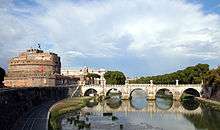
- 🌍 Castel Sant'Angelo, Lungotevere Castello 50, ☎ +39 06 32810. Daily 09:00-19:30 (last entry 1h before closing). Perhaps the most fascinating building in Rome. The core of the structure began life as the mausoleum of Emperor Hadrian, built between 135 and 139 AD. Subsequent strongholds built on top of the mausoleum were in turn incorporated into a residence and castle by medieval Popes. The building was used as a prison until 1870 but now houses a museum. Opera buffs will be exhilarated to visit the balcony from which Tosca leaps to her death. Film buffs will recognize it as a setting from Angels and Demons. €10, with reductions. Roma Pass accepted.
- 🌍 Passetto di Borgo. Pope Nicholas III connected Castel Sant'Angelo to St. Peter's by a covered fortified corridor called the Passetto di Borgo. This proved useful for Pope Clement VII during the Sack of Rome (1527). You can still see much of the Passetto by walking along the Borgo Sant'Angelo, which runs parallel to, and north of, the Via della Conciliazione.
- 🌍 Palazzo di Giustizia (Palace of Justice). Wandering around the shopping and residential district of Prati, close to the Vatican, you may notice rather a lot of lawyers' nameplates outside buildings. This is also Rome's legal district because of the proximity of the Palazzo di Giustizia or Palace of Justice. This massive monstrosity on the banks of the Tiber was built on alluvial soil, which necessitated a concrete platform to support the foundations. Despite this, later settlement of the building led to the need for restoration work in 1970 and it is said to be still sinking. There were many allegations of corruption during its construction, something not unknown in the Rome of today, and this, combined with its appearance, gave rise to its nickname of the Palazzaccio or Ugly Palace.
- 🌍 Ponte Sant'Angelo. This is a footbridge connecting Castel Sant'Angelo with the other side of the Tiber. It is a Roman bridge completed in 134 AD by Hadrian, to give access to his newly constructed mausoleum. Pilgrims used this bridge to reach St Peter's Basilica, hence it was earlier known as the "bridge of Saint Peter". In the seventh century, the castle and the bridge took on the name Sant'Angelo, when it is said that an angel appeared on the roof of the castle to announce the end of a plague. The statues of ten angels on the bridge reflect its name.
Do
While guidebooks do their best to provide an aid for viewing the collections inside the Vatican, a guided tour is a far better way to make sure you get the most out of your visit.
Vatican tours
Guided tours are provided by the Vatican itself for the cost of €30. These may be requested in advance by fax from one month to one week before the requested tour date, or online from two months before the requested tour date. The Vatican is notorious for failing to reply via fax, and repeat requests are often necessary. Full details on booking such tours are available at the Vatican web site.
Two-hour English tours of the Vatican Museum cost €31 and include museum admission, and leave at 10:30, 12:00 and 14:00 in summer, and 10:30 and 11:15 in winter. To reserve, book online. Other contact details: for groups visiteguidategruppi.musei@scv.va, for individuals: visiteguidatesingoli.musei@scv.va, tel. +39 06 69883145 or +39 06 69884676, fax +39 06 69873250. With a booking you skip the queue and enter through the exit, next to the entry, to go to the guided tours desk.
Guided tours are the only way to see the quiet and peaceful Vatican Gardens, either by foot (€32, duration 2 hr) or by open bus (€36, duration 40 min). Ticket prices for both types of tours include access (without a guide) to the Vatican Museum. Book at least a day in advance by calling 06-6988-4676 or book online. Tuesday, Thursday, & Saturday at 10:00, depart from tour desk and finish in St. Peter's Square.
To tour the Necropolis and Saint's Tomb, call the excavations office at least a week in advance at 06-6988-5318, €10 for a 2-hour tour, office open Monday to Saturday 09:00-17:00.
Go to Mass
If you're Catholic (or even if you're not), you can go to religious services in any of the four Basilicas of the City, including St. Peter's. All four have Mass daily, some hourly during daylight hours (generally 07:00–15:00).
Mass in St Peter's Basilica is held daily at 08:30, 10:00, 11:00, 12:00, and 17:00 from Monday to Saturday, and Sundays and religious holidays at 08:30, 10:30, 11:30, 12:10, 13:00, 16:00, & 17:30. Visits to the basilica are still possible while Mass is in progress.
Buy
The Vatican has a unique, non-commercial economy that is supported financially by contributions (known as Peter's Pence) from Roman Catholics throughout the world. It also sells postage stamps, tourist mementos, and publications. Fees for admission to museums also go into church coffers.
The Vatican euro coins are the rarest in circulation among the European countries, so don't spend them! They are worth a lot more than their face value.
- 🌍 Sabatini, Via Germanico, 168/A, ☎ +39 06 36003966. M-F 09:00–13:00, 15:00-19:00; Sa 09:00-13:00. Sabatini is a short walk from the Vatican and one of the best camera shops in Rome.
- 🌍 Savelli Religious, Via Paolo VI, 27-29, ☎ +39 06 6830 7017. M-Sa 09:00–18:30; Su 09:00-13:30. Savelli Religious is across the street from St. Peter's Square and have jewelry, crosses and catholithic statues. Most things here are blessed by the Pope.
- 🌍 St. Peter's Gallery (Galleria San Pietro), Largo del Colonnato, 5, ☎ +39 06 686 5450. Open 24 hours. A pretty expensive souvenir shop with some religious items. The bypass-the-line tickets to the Vatican Museums are sold here.
Eat and drink
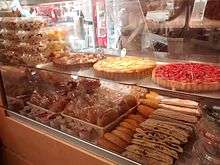
The Vatican Museums have a reasonable cafeteria-style restaurant, a bar, and a pizzeria, all of which are open during museum opening hours, and until about one hour after closing. As you might expect, the food is a little overpriced and not exactly gourmet, but when you get hungry halfway through the museums, it does the trick. See also Rome.
- Old Bridge. Located across the street from the Vatican City wall if you're following it from San Pietro to the Vatican Museum. Very cheap.
- Fruit Gelato Shop. Right across from the Vatican Museum entrance. Delicious fruit gelato with exotic fruit bits and ice creams.
- 🌍 Osteria delle Commari, Via Santamaura, 23, ☎ +39 06 3972 9557. noon-23:00 every day. A Roman italian food restaurant that does not have pizza. A little expensive.
- 🌍 Pastasciutta, Via delle Grazie, 5, ☎ +39 349 258 6793. M-Sa 10:30-18:30 Su 10:30-18:00. Quick pasta and pizza restaurant, and portions are large. Very cheap.
Prati
- 🌍 Siciliainbocca, Via Emilio Faa di Bruno 26 (Metro line A, Cipro.), ☎ +39 06 373 584 00. Nice Sicilian restaurant in the quiet (and somewhat boring) part of northern Prati. Try the swordfish and the lemon sorbet! reasonable. Fish plate around €15, but do order some antipasti and pasta.
- Insalata Ricca, Via Fulcieri Paulucci De' Calboli (Near piazza Manzoni). Part of a Rome-based chain, offers good salads and other food to both tourists and locals. Cheap.
- 🌍 Be.Re, Via Vespasiano, 2, ☎ +39 06 944 218 54. 11:00-2:00 every day. Good selection of craft beers, many on tap. If you're a beer lover, it's definitely worth going. Some snacks too, try some Trapizzino (triangular filled pizza).
Sleep
Unless you count the Pope as a good friend (and he concurs), there are no lodging opportunities in the Vatican City itself. However, there are many hotels in the surrounding Vaticano neighborhood of Rome.
Budget
- 🌍 B&B Eldorado Rome, Via Fabio Massimo, 72, ☎ +39 329 0707988. Check-in: midnight, check-out: 10:30. Bed and Breakfast with 5 double bedrooms. Three with private bath, two with a shared one. Breakfast included. Rates change according to the season. Single: €50-100 Double: €60-140 Triple: €80-160.
- 🌍 Infinity St Peter Hotel, Via Catone, 34, ☎ +39 06 39735082, fax: +39 06 39754358. With single, twin, double, triple and quadruple rooms. All with private bath, shower, internet access, TV and telephone. From €80 (March 2019).
- 🌍 LtRooms, Via Umberto Moricca, 5 (a few steps from the Metro Line A), ☎ +39 392 858 1039, e-mail: info@ltrooms.com. Check-in: 10:30. From €50 per room.
- 🌍 Hotel Colors, Via Boezio, 31, ☎ +39 06 6874030, fax: +39 06 6867947. Seven dorms and wide selection of bedrooms with private showers, TV and a shared kitchen for this two star accommodation next to the Vatican City. Suitable for families and young travelers.
- 🌍 Franklin Feel The Sound Hotel, Via Rodi, 29, ☎ +39 06 3903 0165, fax: +39 06-39751652, e-mail: franklin@franklin.it. Hotel with a unique music theme. The décor is very modern and stylish. Staff was helpful friendly and polite, continental breakfast is varied and plentiful. The rooms are clean, funky and very comfortable. From €35.
- 🌍 Prati BB, Via degli Scipioni, 135, ☎ +39 06 321 1329, e-mail: info@pratibb.it. A small Bed and Breakfast offering two rooms with private bathrooms and air-con. from €45.
- 🌍 B&B Gli Artisti, Via degli Scipioni, 53, ☎ +39 338 207 8356. Three colourful rooms are rented out in this B&B. A little less than a kilometer from the main entrance to the Vatican. Tours of the Vatican Museums are availible here for €42. From €64.
- 🌍 Filomena e Francesca B&B (Filomena e Francesca F&F), Via della Giuliana, 72, ☎ +39 06 3751 3625, e-mail: info@bbfandf.com. Bed and Breakfast. Three rooms with private bathrooms and air-con. from €40.
- 🌍 Mocenigo Vatican Suites, Via Mocenigo, 16, ☎ +39 338 382 3606, e-mail: stay@mocenigovaticansuites.com. Check-in: 14:00, check-out: 10:00. Seven-room guesthouse 100 m from the main entrance to the Vatican Museums. From €75.
Mid-range
- 🌍 Amor Bed & Breakfast, Viale Giulio Cesare, 183, ☎ +39 335 568 9388, e-mail: info@amor-bb.com. Check-in: 12:00, check-out: 11:00. A stylish bed & breakfast near the Vatican City. From €80.
- 🌍 Atlante Star Hotel, Via Giovanni Vitelleschi, 34, ☎ +39 06 687 3233. Check-in: 14:00, check-out: 11:00. Four-star hotel with rooftop terrace restaurant overlooking Saint Peter's. From €120.
- 🌍 B&B Sistine, Via Duilio, 6, ☎ +39 335 871 4840. Rooms come with sat TV, DVD player and free Wi-Fi From €120.
- 🌍 Best Vatican, Via degli Scipioni, 135, ☎ +39 335 871 4840. Modern B&B. Private bathrooms, LCD TVs with DVD players. From €120.
- 🌍 Hotel Joli Rome, Via Cola di Rienzo, 243, ☎ +39 06 324 1854, fax: +39 06 360 06637. Two-star accommodation located around the Vatican area with 17 bedrooms divided into single, double, triple and family. Most of the rooms have private bath. Breakfast included. €109, single €99.
- 🌍 Leone B&B, Via Leone IV, 109, ☎ +39 338 611 2656, fax: +39 06 320 3663, e-mail: info@leonebb.it. Three blocks from the entrance to Vatican City, this independent bed and breakfast is clean and cosy. Breakfast included. €90, single €70.
- 🌍 PapavistaRelais, Via Tunisi, 3 (Metro station Cipro), ☎ +39 06 6542 0553. Guesthouse fairly close to the Vatican's main entrance. From €80.
- 🌍 Hotel Silla Rome, Via Silla 3, ☎ +39 06 372 1922, fax: +39 06 372 1922. Two star hotel with single, double, triple and quadruple rooms. All with en suite private bath, shower, telephone and TV. Air-con and breakfast are available for a small supplement. Change seasonally: single €70-110, double €85-150, triple €120-175, quadruple €140-200.
- 🌍 Maison Vaticana Rome, Via Ottaviano, 42, ☎ +39 06 39728070, fax: +39 06 233249447. Comfortable bed and breakfast with single, double, triple and quadruple guestrooms with private bathroom, Wi-Fi connection, satellite TV and tea and coffee facilities. Double bedrooms €85.
- 🌍 Rome Armony Suites B&B B&B, Via Orazio, 3, ☎ +39 06 9784 1129, fax: +39 06 9784 1129, e-mail: info@romearmonysuites.com. Elegant bed and breakfast. Recently refurbished, has six rooms, all with private bathroom and super-equipped with every comfort. From €80.
Splurge
- 🌍 Best Western Plus Hotel Spring House, Via Mocenigo 7, ☎ +39 06 3972-0948, fax: +39 06 39721047, e-mail: hotelspringhouse@gmail.com. A small 3-star hotel with rooms that are a bit small, but comfortable and quiet. Great breakfast, wonderful service (maids and reception). €120-240.
- 🌍 Gran Meliá Rome, Via del Gianicolo, 3, ☎ +39 06 925901, fax: +39 06 92590300, e-mail: gran.melia.rome@melia.com. Check-in: 15:00, check-out: 12:00. A luxury 5-star hotel with single, double, triple and quadruple rooms, very quiet with a view of Vatican City. from €200.
- 🌍 Hotel Alimandi Tunisi, Via Tunisi 8, ☎ +39 06 3972 3941. Nice three-star hotel, 35 bedrooms with air conditioning and free Wi-Fi, large common area, complimentary breakfast, and terrace with panoramic view of the Roman roofs. From €140.
- 🌍 Residenza dei Gracchi Rome, Via dei Gracchi, 84, ☎ +39 06 320 8226. Cosy guest house with single, double and family rooms. All with Wi-Fi, flat screen TV, private bath, shower, air-con and cleaning services. €80-180.
Stay safe
Because of the dense crowds of dazzled tourists, St. Peter's Square and the Sistine Chapel are favorite spots for pickpocketers. Keep an eye on your belongings throughout your trip to the Vatican—even tour guides occasionally get pickpocketed here.
Connect
Mail a letter - since Vatican City is a separate sovereign state, it also has its own postal system, which is generally considered to be a bit more reliable than that of surrounding Italy. Send a postcard to your friends and it will be postmarked from Vatican City.
Cope
- Vatican News. News from the Vatican and about the Church.
- 🌍 Vatican Pharmacy, ☎ +39 06 698-898-06.
Respect
Since Vatican City is a Papal state, respect for the Roman Catholic Church and its practices and doctrine is encouraged.
Sleeveless shirts and short pants or skirts are not permitted within the border of the Vatican. This is rarely enforced, but you will be refused entry to the Basilica and museum (or anywhere else with a security check).
Go next
Right outside the borders, the amazing attractions of the global city of Rome await you. If you're up for some more historic sightseeing, visit the beautiful piazzas and palazzos of Old Rome or head to the ancient Roman ruins in the Colosseo district. If not, the hustle and bustle of the Modern Centre with all its shopping opportunities and colorful nightlife might be just what you are looking for.
If you can't get enough of the papal atmosphere, head to the San Giovanni neighborhood to visit San Giovanni in Laterano, the Pope's cathedral in his role as Bishop of Rome. The small city of Viterbo also makes a good next stop. This is where popes took refuge when they were driven out of Rome and where six of the 13th-century popes had their seat.
| Routes through Vatican |
| END ← North ← | W |
→ North Center → Modern Center |
